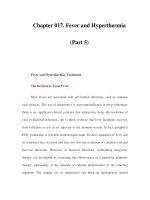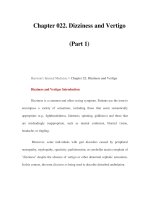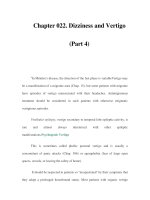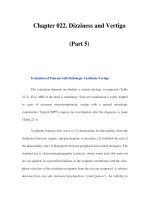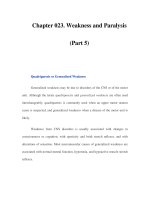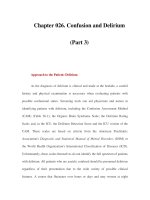Chapter 022. Dizziness and Vertigo (Part 5) pptx
Bạn đang xem bản rút gọn của tài liệu. Xem và tải ngay bản đầy đủ của tài liệu tại đây (15.53 KB, 6 trang )
Chapter 022. Dizziness and Vertigo
(Part 5)
Evaluation of Patients with Pathologic Vestibular Vertigo
The evaluation depends on whether a central etiology is suspected (Table
22-2). If so, MRI of the head is mandatory. Such an examination is rarely helpful
in cases of recurrent monosymptomatic vertigo with a normal neurologic
examination. Typical BPPV requires no investigation after the diagnosis is made
(Table 22-1).
Vestibular function tests serve to (1) demonstrate an abnormality when the
distinction between organic and psychogenic is uncertain, (2) establish the side of
the abnormality, and (3) distinguish between peripheral and central etiologies. The
standard test is electronystagmography (calorics), where warm and cold water (or
air) are applied, in a prescribed fashion, to the tympanic membranes, and the slow-
phase velocities of the resultant nystagmus from the two are compared. A velocity
decrease from one side indicates hypofunction ("canal paresis"). An inability to
induce nystagmus with ice water denotes a "dead labyrinth." Some institutions
have the capability of quantitatively determining various aspects of the VOR using
computer-driven rotational chairs and precise oculographic recording of the eye
movements.
CNS disease can produce dizzy sensations of all types. Consequently, a
neurologic examination is always required even if the history or provocative tests
suggest a cardiac, peripheral vestibular, or psychogenic etiology. Any abnormality
on the neurologic examination should prompt appropriate neurodiagnostic
studies.Vertigo: Treatment
Treatment of acute vertigo consists of bed rest (1–2 days maximum) and
vestibular suppressant drugs such as antihistaminics (meclizine, dimenhydrinate,
promethazine), tranquilizers with GABA-ergic effects (diazepam, clonazepam),
phenothiazines (prochlorperazine), or glucocorticoids (Table 22-3). If the vertigo
persists beyond a few days, most authorities advise ambulation in an attempt to
induce central compensatory mechanisms, despite the short-term discomfort to the
patient. Chronic vertigo of labyrinthine origin may be treated with a systematized
vestibular rehabilitation program to facilitate central compensation.
Table 22-3 Treatment of Vertigo
Agent
a
Dose
b
Antihistamines
Meclizine 25–
50 mg 3
times/day
Dimenhydrinate 50
mg 1–2
times/day
Promethazine
c
25–
50-mg
suppository
or IM
Benzodiazepines
Diazepam 2.5
mg 1–3
times/day
Clonazepam 0.25
mg 1–3
times/day
Phenothiazines
Prochlorperazine
c
5 mg
IM or 25 mg
suppository
Anticholinergic
d
Scopolamine
transdermal
Patch
Sympathomimetics
d
Ephedrine 25
mg/d
Combination
preparations
d
Ephedrine and
promethazine
25
mg/d of
each
Exercise therapy
Repositioning
maneuvers
e
Vestibular
rehabilitation
f
Other
Diuretics or low-
salt (1 g/d) diet
g
Antimigrainous
drugs
h
Inner ear surgery
i
Glucocorticoids
c
100
mg/d for 3
days,
tapered by
20 mg every
3 days
